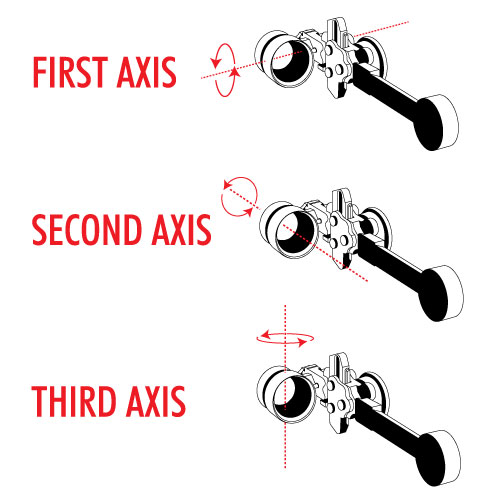Still new to shooting past 1k so if this question is completely "wrong", just say no, I don't mind.
Anyways, just realized that no one in long range shooting talks about the "3rd" axis of alignment vs in archery, all 3 axis of alignment get dialed in on the sight, assuming the user is aware of the issue and the sight has the adjustment capability.

 lancasterarchery.com
lancasterarchery.com
For reference, 1st axis in the link above would be like looking up and down a hill, 2nd axis is what we would traditionally think of as cant on a bipod (and what bubble levels on both rifles and bows check for), and 3rd axis would be like panning the rifle or possibly a barrel / bullet hole that isn't square against the receiver or otherwise doesn't point where the scope points. I don't think first axis is a concern in either given that we aim up/down for different distances anyways. And 2nd we normally look for and correct. However, I'm wondering about the 3rd axis.
Do we simply not worry about it because 1) scopes are long enough to prevent most of the above from happening at a practical level, i.e. we would see it and fix it), 2) modern rifle manufacturing is typically good enough to prevent too much of the above and 3) what little we can't catch would be negligible vs all other factors or simply approximated out at different distances with our DOPE data?
For example, in an extreme example, imagine a scope that's sitting 2deg panned to the right but is level otherwise and the barrel + receiver is point forward at 0deg and otherwise level. Now if we shoot up or down hill, not only would the scope be pointing off to the right, but it would be canted as well, throwing things off in 2 directions, of course with the error becoming more as we go further out. Now, imagine the same thing but at amounts within tolerance stacking, etc. - probably not a real issue at say 100yds, but I'm wondering if this is a factor past 1000.
EDIT: Yep, pretty much what I thought. Curiosity answered.
Anyways, just realized that no one in long range shooting talks about the "3rd" axis of alignment vs in archery, all 3 axis of alignment get dialed in on the sight, assuming the user is aware of the issue and the sight has the adjustment capability.

The three axes of a bow sight
Did you know your compound bow sight has three axes?Did you know “axes” is the plural of “axis?”An axis, of course, is an imaginary line around which an object rotates. To achieve a truly level sight – which is critical for accuracy - you have to account for all three axes.Not all sights allow...
For reference, 1st axis in the link above would be like looking up and down a hill, 2nd axis is what we would traditionally think of as cant on a bipod (and what bubble levels on both rifles and bows check for), and 3rd axis would be like panning the rifle or possibly a barrel / bullet hole that isn't square against the receiver or otherwise doesn't point where the scope points. I don't think first axis is a concern in either given that we aim up/down for different distances anyways. And 2nd we normally look for and correct. However, I'm wondering about the 3rd axis.
Do we simply not worry about it because 1) scopes are long enough to prevent most of the above from happening at a practical level, i.e. we would see it and fix it), 2) modern rifle manufacturing is typically good enough to prevent too much of the above and 3) what little we can't catch would be negligible vs all other factors or simply approximated out at different distances with our DOPE data?
For example, in an extreme example, imagine a scope that's sitting 2deg panned to the right but is level otherwise and the barrel + receiver is point forward at 0deg and otherwise level. Now if we shoot up or down hill, not only would the scope be pointing off to the right, but it would be canted as well, throwing things off in 2 directions, of course with the error becoming more as we go further out. Now, imagine the same thing but at amounts within tolerance stacking, etc. - probably not a real issue at say 100yds, but I'm wondering if this is a factor past 1000.
EDIT: Yep, pretty much what I thought. Curiosity answered.
Last edited:


